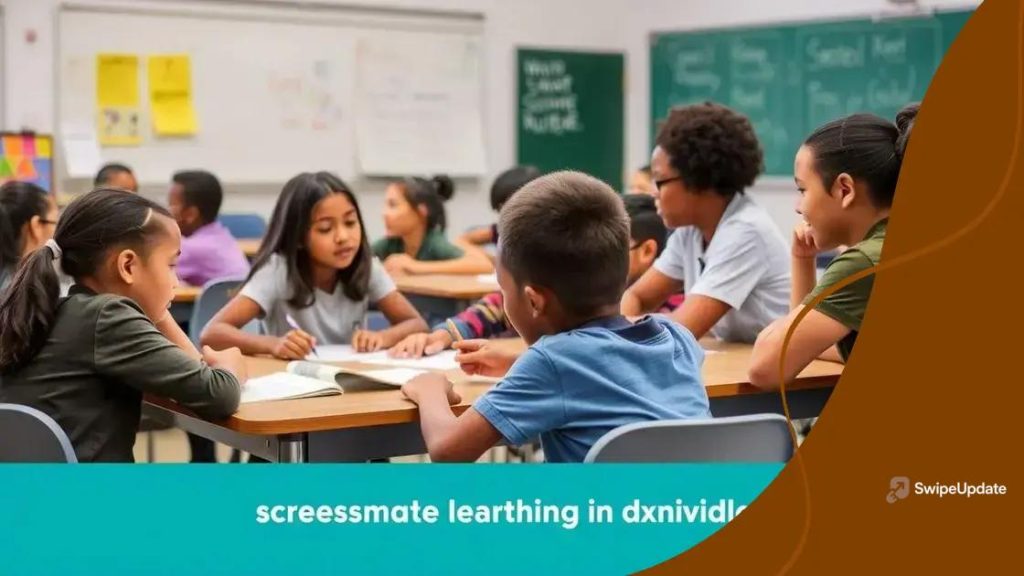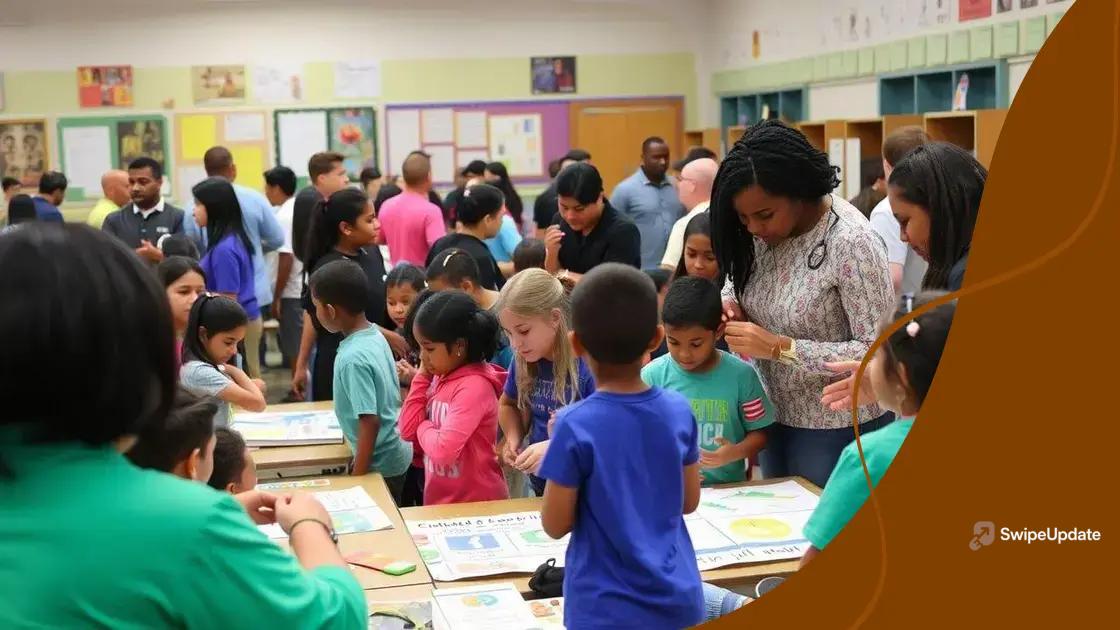Strategies for overcoming learning deficits after the pandemic

Creating supportive learning environments involves building strong relationships, providing tailored resources, integrating social-emotional learning, and actively involving families to enhance student engagement and success.
Strategies for overcoming learning deficits after the pandemic are crucial for helping students regain lost ground. As educators and parents, we must explore effective approaches to support learning and engagement. Have you considered how these strategies can shape your child’s future?
Understanding learning deficits caused by the pandemic
Learning deficits caused by the pandemic have affected students worldwide. It’s crucial to understand what these deficits are and how they can impact a child’s education. Many students experienced disruptions in their learning routines, leading to lost knowledge and skills. This situation can create long-term challenges that we must address.
Types of Learning Deficits
Learning deficits can manifest in various ways. For example, students may struggle with core subjects such as math and reading. The lack of in-person interaction hindered their ability to learn effectively. Additionally, social skills development was often compromised during remote learning.
Factors Contributing to Deficits
- Inconsistent Learning Environments: Some students had to shift frequently between online and in-person classes, leading to confusion and gaps in learning.
- Access to Resources: Not all students had equal access to technology or safe learning spaces at home, affecting their ability to engage with the curriculum.
- Emotional and Social Struggles: Isolation during the pandemic contributed to stress and anxiety, which can further impede academic performance.
To tackle these issues, it is essential to identify the specific areas where students are struggling. Teachers and parents should monitor progress closely and communicate regularly. Engaging students in discussions about their difficulties can help them feel more supported and understood. By working together, we can develop targeted strategies to help each child catch up.
Furthermore, incorporating hands-on learning and interactive methods can enhance engagement. Utilizing small group activities and peer tutoring may also provide the personal interaction that many learners missed during remote education. Consistent feedback from educators can further strengthen understanding, leading to improved performance.
Ultimately, addressing learning deficits requires a collaborative approach. Schools, families, and communities must come together to support students. Through understanding the nature of these deficits, we can create effective strategies that promote learning and resilience.
Identifying key areas of focus for recovery
Identifying key areas of focus for recovery is essential for helping students overcome learning deficits. Each child’s experience during the pandemic may vary, making it vital to assess their unique needs. Recognizing these areas allows educators to create personalized plans that cater to specific challenges.
Academic Skills Assessment
One crucial area is assessing academic skills. Teachers can use informal assessments or standardized tests to determine where students stand. This evaluation helps identify subjects that require additional support, such as reading or math. With a clear understanding of strengths and weaknesses, targeted instruction can be developed.
Social and Emotional Well-being
Another key area is the social and emotional well-being of students. The pandemic has impacted friendships and social interactions significantly. Teachers and parents should monitor changes in behavior or mood. Programs that promote social skills and emotional resilience can support students in rebuilding these essential connections.
Engagement Strategies
- Interactive Learning: Incorporate hands-on activities that engage students directly in the learning process.
- Peer Collaboration: Encourage group work to foster teamwork and communication skills among students.
- Goal Setting: Help students set achievable academic and personal goals, promoting a sense of ownership in their learning.
In addition, fostering a positive learning environment is vital. Creating spaces where students feel safe to express themselves encourages openness and resilience. Regular check-ins with students can facilitate communication about their needs and challenges. By prioritizing these areas, we can better support recovery and ensure that students thrive.
Moreover, incorporating feedback loops, where students share their thoughts on what helps them learn best, can enhance engagement. Continuous assessment and adaptation support a dynamic learning experience that evolves as students grow. Finding the right balance of academic, social, and emotional support is the key to fostering recovery.
Engaging parents and communities in education

Engaging parents and communities in education is essential for fostering a supportive learning environment. When parents are involved, students often perform better academically and socially. It is crucial to create opportunities for families to participate actively in their children’s education.
Importance of Parental Involvement
Parental involvement has a significant impact on student success. Research shows that when parents are engaged, students are more motivated and have improved behavior. Schools can benefit from fostering strong relationships with families by providing ways for them to get involved.
Ways to Encourage Engagement
- Regular Communication: Keep parents informed about school events, student progress, and opportunities for involvement through newsletters or meetings.
- Workshops and Resources: Offer workshops that help parents understand how to support their children’s learning at home, covering topics such as homework help and study skills.
- Volunteer Opportunities: Create various volunteering options for parents, allowing them to contribute their skills, whether in the classroom or during school events.
Building a sense of community between schools and families is vital. Schools should host community events where parents can meet teachers and other families. This connection allows parents to feel more invested in their children’s education. Additionally, partnerships with local organizations can provide resources and support for families.
Listening to parents’ feedback is also crucial. Surveys and open forums can help gather insights into what parents feel is essential for their children’s education. Implementing their suggestions shows that the school values their input, fostering a collaborative environment.
Moreover, advocacy for community involvement is essential. Schools can create outreach programs that invite local businesses and organizations to participate. Partnering with community leaders can enhance educational programs and increase resource availability.
Utilizing technology for personalized learning
Utilizing technology for personalized learning can significantly enhance a student’s educational experience. By leveraging various digital tools, educators can tailor solutions that meet each student’s individual needs. This approach allows for greater engagement and better learning outcomes.
Benefits of Personalized Learning
One major benefit of using technology in personalized learning is that it caters to different learning styles. Some students may prefer visual aids, while others thrive with auditory resources. With technology, teachers can provide a variety of materials, ensuring that every student has access to the methods that work best for them.
Tools for Personalization
- Learning Management Systems (LMS): Platforms like Google Classroom and Canvas allow educators to create customized lesson plans and track student progress.
- Adaptive Learning Software: Programs like DreamBox and IXL adjust the difficulty of tasks based on the student’s performance, ensuring they are challenged appropriately.
- Online Resources: Websites like Khan Academy offer personalized learning paths that allow students to learn at their own pace.
Implementing technology also promotes student autonomy. When students can choose their learning paths, they feel more in control of their education. This autonomy can lead to higher motivation and better retention of information. Moreover, technology facilitates immediate feedback, allowing students to understand their mistakes and correct them right away.
Schools should invest in training for educators on how to effectively use technology to personalize learning experiences. Professional development can help teachers discover new tools and strategies that enhance their teaching. Collaboration among educators about successful tech integration can lead to innovative practices that benefit all students.
While utilizing technology for personalized learning is promising, it’s essential to ensure that all students have access to the necessary devices and internet. Equity in technology use must be a priority to avoid widening the achievement gap. Schools and communities can work together to provide resources and support for families in need.
Creating supportive learning environments
Creating supportive learning environments is essential for student success. A positive atmosphere encourages students to engage, take risks, and feel valued. When students feel safe both emotionally and physically, they are more likely to thrive in their academic pursuits.
Elements of Supportive Environments
One key element is fostering relationships. Positive interactions between teachers and students create trust and respect. When students know their teachers care about them, they are more willing to participate and seek help when needed. Additionally, promoting peer relationships enhances collaboration and social skills.
Physical Space Considerations
- Comfortable Seating: Ensure that students have comfortable places to sit. Flexible seating arrangements can help students feel more at home.
- Inviting Decor: Use colorful decorations and displays of student work to create a welcoming atmosphere.
- Quiet Areas: Provide spaces where students can retreat when they need a break or a quiet place to think.
Equally important is integrating social-emotional learning (SEL) into the curriculum. SEL focuses on skills such as self-awareness, empathy, and relationship-building. Incorporating activities that promote these skills can help students navigate their emotions and social interactions more effectively.
Furthermore, encouraging student voice and choice is vital. Allowing students to make decisions about their learning fosters a sense of ownership. When students feel they have a say in their education, they become more invested and motivated. This can be achieved through project-based learning and collaborative group work.
Lastly, involving families in the process can strengthen the support system. Regular communication with parents about their child’s progress and inviting them to school events can build a community around learning. By creating connections between home and school, we reinforce the importance of education.
FAQ – Questions about Creating Supportive Learning Environments
How can I build strong relationships with my students?
You can build strong relationships by showing genuine interest in their lives, maintaining open communication, and being supportive in their learning journey.
What are some effective resources to support personalized learning?
Effective resources include learning management systems, adaptive learning software, and various online educational platforms that cater to different learning styles.
Why is social-emotional learning important in education?
Social-emotional learning helps students develop essential skills like self-awareness and empathy, which are crucial for their emotional health and academic success.
How can I involve families in my classroom?
You can involve families by regularly communicating updates, inviting them to school events, and providing resources that help them support their children’s learning at home.
